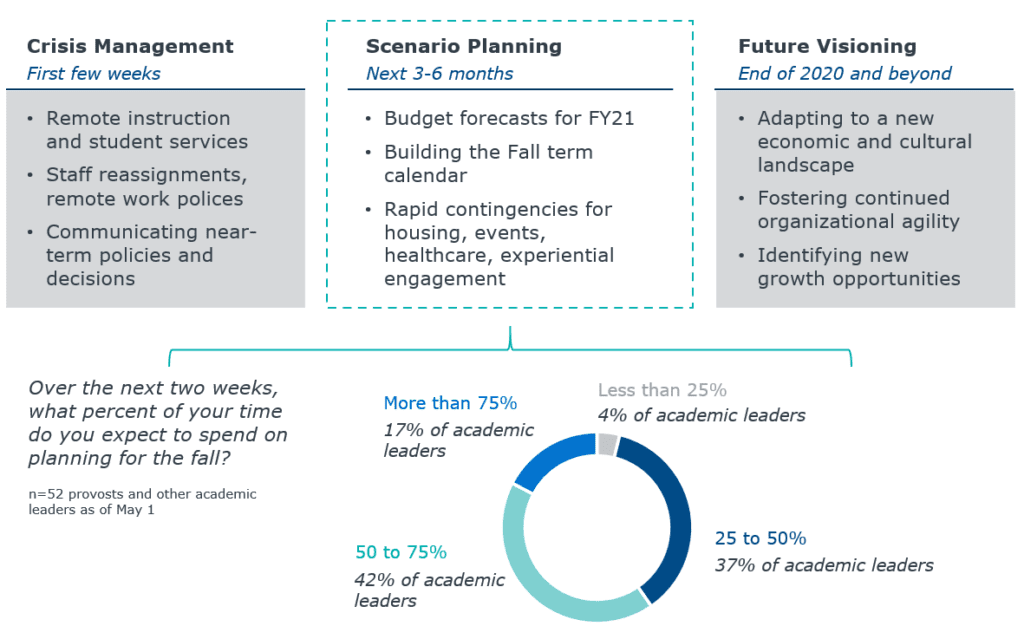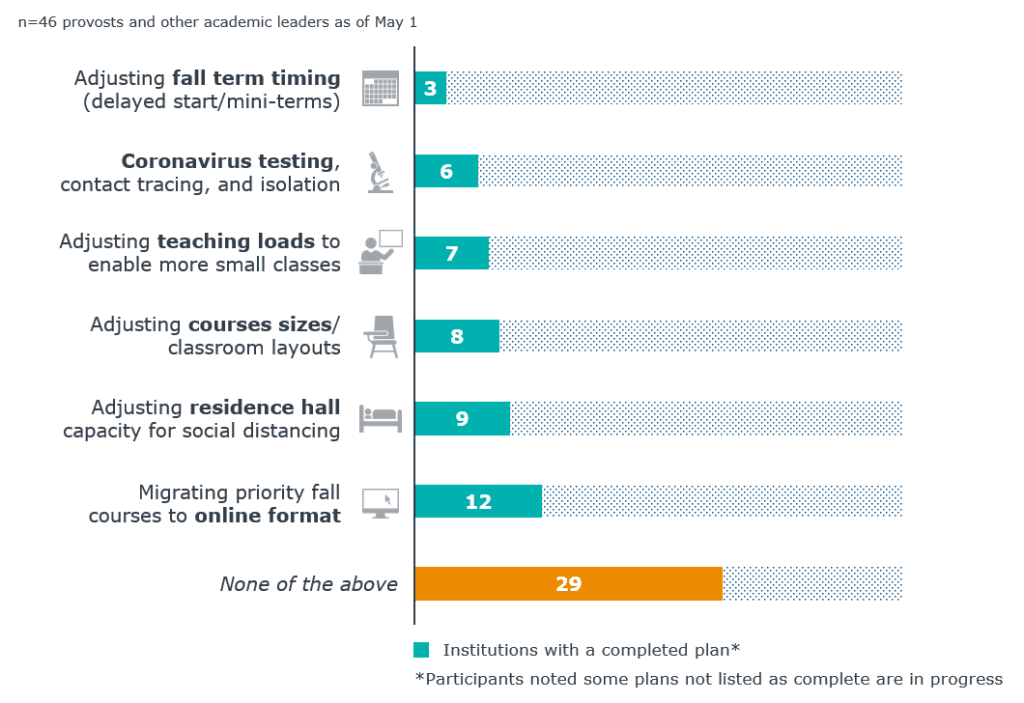59%
In “normal” times, I spent two to four days a week visiting college campuses across North America. I can’t say that I miss all of the airports and the lack of legroom. But I do miss (as I’m sure all of you do too) the incredible energy that comes from being on a vibrant campus, surrounded by so many creative students, faculty, and staff.
As the spring term ends, colleges and universities are moving from the immediate crisis management of the last two months to considering what fall might look like. Uncertainty around the trajectory of the pandemic—and the full economic impact of measures already taken to contain it—means schools need to plan for multiple fall scenarios. How will we need to restructure the layout of classrooms and residence halls? How should we transition even more courses to online delivery? Will the coming recession reduce enrollment in higher education? Institutions across the country are now dedicating significant time to grappling with these questions.
Where academic leaders find themselves: fall scenario planning

Read on for a discussion of three questions guiding fall scenario planning, and emerging trends in how colleges and universities are responding to the uncertainty.
1. What will enrollment look like?
New evidence emerges daily that colleges and universities will face decreased persistence among current students and decreased yield among admitted students this fall. According to the National College Attainment Network, FAFSA renewal, usually a leading indicator of enrollment, is down 5% compared to this time last year. FAFSA completion among high school seniors is also down compared to last year.
In addition to overall enrollments, many leaders are concerned about enrollment from specific demographic groups. The FAFSA renewal decline is particularly acute among low-income students, and international enrollments are uncertain given potential travel and visa restrictions. Even two-year and access-focused four-year institutions are questioning whether they can count on the countercyclical enrollment bump they typically see during a recession.
Institutions are designing new approaches to combat the impending enrollment decline. A point of much debate in our recent conversations is the idea of recruiting students accepted or enrolled at other institutions (now permissible under NACAC’s updated Code of Ethics and Professional Practice).
In the wake of the COVID-19 pandemic we see a growing number of schools considering marketing to students who live close by but enroll in out-of-state institutions. Last week, for example, 10 public institutions in New Jersey launched the NJ Come Home initiative to encourage residents to transfer to in-state schools to help the region recover from the economic impacts of COVID-19. The initiative touts lower in-state tuition and easy credit transfer in addition to service learning opportunities.
Other strategies colleges and universities are considering include:
- Reducing barriers to registration
- Providing emergency financial aid
- Reaching out proactively to students not taking steps to reenroll
- Leveraging underutilized staff for individualized outreach
- Hosting virtual yield events and virtual campus tours
- Communicating with students and parents in a timely manner
- Supporting students and staff in creating authentic videos about their experience
- Providing discounts and incentives for early commitment
- Offering discounts for summer online courses
- Developing or promoting short, inexpensive skills training for working adults
1 in 4
2. What will the budget look like?
Cost cutting is inevitable in the face of the coming economic downturn, leaving leaders to determine the right cuts to help their institutions balance immediate recovery and long-term sustainability. Many possible approaches will require difficult choices now, even though the scope of necessary cuts will not be clear until the fall.
We’ve seen our partner institutions implement the following cost cutting measures, in order from most to least common:
| Freezing spending | This could include freezing hiring, salaries, and/or external spending, pausing or delaying capital projects, and not rehiring contract employees |
| Reducing compensation | This could include staff furloughs, progressive staff pay cuts, and reducing health and/or retirement benefits |
| Reducing staff | This could include staff layoffs, academic program cuts, and faculty layoffs |
| Restructuring the organization | This could include consolidating locations, consolidating academic departments and colleges, redesigning senior leadership roles, and reducing the number of athletic teams |
3. What might “open” look like in the fall?
Listen to the related podcast
Join us as our experts explore how colleges are seeking to anticipate fall 2020 with scenario planning.
Listen NowWhether institutions allow students to return to campus with moderate social distancing, push back the start of term, or have a fully online term, “opening” for fall will require significant and complex adaptation of current policies. Colleges and universities are likely to need new policies for interactions on campus, travel to campus, residential capacity, and instructional capacity. Further, schools will need to develop these new policies knowing they may need to become more or less restrictive with little notice.
Our recent survey of academic leaders found institutions are more likely to have plans completed for migrating more courses to online delivery and adjusting residence hall capacity. Few institutions have completed scenario plans involving a delayed fall term start date.
Which of the following fall scenarios have you completed a plan for?

Many leaders we’ve spoken to are in the process of creating these scenario plans, but some note they don’t have enough data yet. In this way, COVID-19 response highlights problems colleges and universities were already grappling with before the pandemic: most campus technology systems are not set up to deliver data and insights quickly, and many institutions do not have the processes or culture that encourage swift decisions.
The only constant is change
Making decisions to shape the fall term will require leaders to navigate a complex matrix of safety concerns, bodies of authority, and shifting higher ed dynamics. To plan for multiple scenarios and remain agile amid ongoing uncertainty, academic leaders need access to reliable data about the institution’s current performance.
It’s also important not to let planning get in the way of preparation. Given the level of uncertainty about what the fall will look like, focus on those things that you can control—engaging regularly with students and admits, supporting faculty to prepare for hybrid course delivery in the fall, helping staff re-engineer rigid processes that will make rapid adjustments more difficult. Colleges and universities aren’t used to dealing with this level of ambiguity, but the one thing that we can say with certainty about the fall is that it will be unpredictable.


